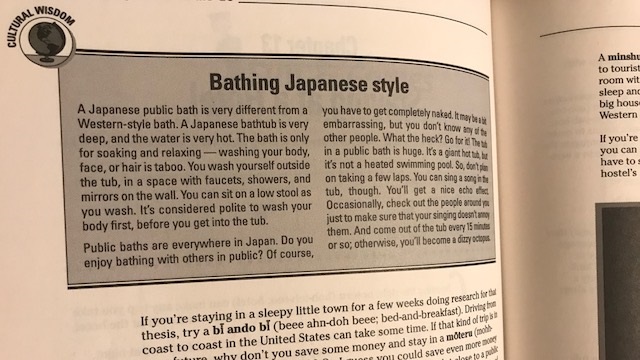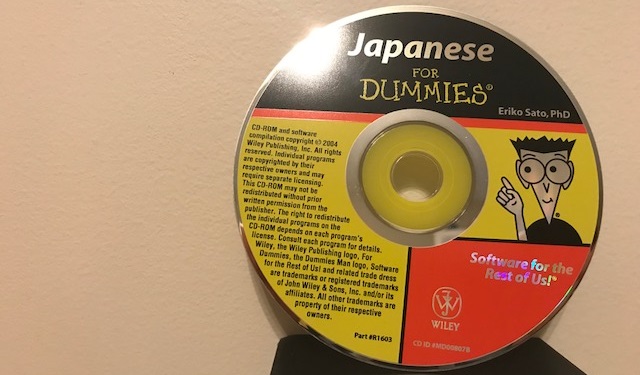How many of you have ever used one of the “for Dummies” books that take a complicated topic and break it down into a way that is easy to understand? Well there’s one for Japanese too! I decided to do a review of the Japanese for Dummies books so you could see if they are worth using or not.
There are two books that you can get, the full book (which I have) and the second book that is called “Japanese Phrases for Dummies.”
It’s the exact same material in both, the difference is that the “phrases” book doesn’t contain the audio lessons and activities that are in the full version.
For that reason alone, I will refer to the primary book (written by Eriko Sato) for this review since you can pretty much apply all of the pros and cons to both. Let’s begin!
Overview of the Book
The tagline for the “… For Dummies” books is “References for the rest of Us!” And that’s a pretty good point to keep in mind for this book.
It is aimed at introducing the spoken part of the Japanese language to the reader through an intro on the basics of the language, followed by chapters devoted to specific topics that you’ll find useful while visiting Japan.
It’s actually very similar to the way a typical Japanese phrasebook is laid out. Except that the Japanese for Dummies book is a lot bigger than any phrasebook!
So after learning how to pronounce Japanese, and how to use the most common spoken particles, you’ll learn some vocabulary and phrases that will be useful when you do things such as:
- Talk about money
- Ask for directions
- Stay at a hotel
- Use transportation
- figure out an emergency
- And some other situations as well
Along with the lessons, there are conversations that you can read and listen to (with the CD) that will help you to learn Japanese in action. The dialog utilizes native Japanese speakers, so you can follow along with the written part and then practice it yourself.
And of course, at the end of each chapter is a short quiz that you can take to help review what you’ve just gone over and lock the information in.
I’ve got the first edition of the book, but they actually come out with a second edition a few years ago that is probably a better choice if you are able to pick between the two.
Check Out The Second Edition Of Japanese For Dummies On Amazon!
What Makes it Unique?

In all honesty, most of the information in the book is basic. That’s actually a good thing because the book is primarily aimed at people who have zero knowledge of Japanese and want to start learning it.
So besides things like language basics and common topics, is there anything that makes this book better than the others?
I would have to say that it actually does have a few great gems hidden within it!
The first two treasures are the “Cultural Wisdom” and “Warning!” sections that are contained within the chapters.
Most people know how to say simple phrases such as “how are you” in Japanese, but very few of them know when you should say it and when you should not say it.
Do you know the difference?
It has to do with the amount of time that has passed since you last saw the other person. Even though “O-genki desu ka” translates to “how are you” in English, in Japanese the phrase is used to seriously inquire about a person mental and physical health.
In English, we ask our co-workers “how’s it going?” every day of the week, but in Japanese you wouldn’t say it day after day… after day… after day!
In other words, that phrase is a lot more meaningful in Japanese.
At least, that’s what is explained in the “Cultural Wisdom” and “Warning!” sections on Greetings!!!
You see why I think this book is kind of unique?
I’ll just mention one other thing (though there are more) that makes this book special.
The end of the book has several “top ten” lists that are really cool to read and learn about. Things such as:
- Ten ways to learn Japanese quickly
- Ten things to never do in Japan
- Ten awesome Japanese expressions
- Ten phrases to make you sound more Japanese
And I think you get the idea.
It’s pretty fun, really insightful, and something that you don’t see very often in books that teach you Japanese.
What Does it Do Right?

I think this book is great for beginners, although you certainly don’t have to be a total beginner to get a lot of value out of it.
It really focuses on teaching you to speak Japanese, which will be the most useful thing for anyone who is planning a trip over to Japan any time soon.
The CD is a wonderful addition so that you can actually hear what the language sounds like, and then mimic it to nail the correct pronunciation.
I like that it teaches things about the language, about the culture, and about about Japan in general.
In addition to the explanation on pronunciation, and the use of Rōmaji throughout the book, it also has a special “sounds like this” section to help you say it correctly. Here’s an example (it’s the second line below):
- Ā, arigatō.
ahh, ah-ree-gah-tohh.
Oh, thanks.
This is not ideal for long term studying, but I think it’s fine to get people started and actually have them speaking Japanese right away. Just be sure to listen to the CD that it comes with.
What Could it do Better?
It’s hard to say things like “I wish it taught hiragana” and more advanced things like that since the purpose of the book is to get newbies started in the language.
I do think that the Japanese Phrases for Dummies (the other book) is kind of a waste of space since it doesn’t have any audio to go along with it.
How can you learn to speak a language when you don’t ever get a chance to hear it? You can make some guesses, but you won’t really know it, will you?
Why is the full book OK even though it only uses Rōmaji for pronunciation? Because it has the CD with it. Pretty simple.
Another complaint is that, if you’re serious about learning Japanese, then you’ll be leaving this book on the shelf pretty soon and using a better, more advanced book to continue your studies.
It’s perfect for tourists and great if you know nothing about Japanese, but if your level of Japanese is already at the upper-beginner rank (or even higher), then it won’t really be all that useful for you.
Still, I have a copy myself and I don’t plan on getting rid of it anytime soon.
I like it, I just don’t try to pretend that it’s more than what it really is. You know what I mean?
I’m not the only one who really likes it either. It’s got a lot positive feedback over on the Amazon reviews section.
See What Other People Have Said About It.
Where Can You Find It?
If this is something that you are interested in for your own studies, or if you think it would make a nice gift for a family member who is interested in the language, you can click on the link below to see it on Amazon.
Click Here To See It On Amazon Now!
I think I’ve covered everything you’d need to know about the book in order to decide if it’s right for you or not, but if you have any other questions, or if I forgot to explain anything, please let me know by leaving a comment below.
Also, if you’ve used this book yourself, I would love to have you share you’re experience as well! Thanks!
Further Resources for Learning Japanese:
#3 Get My eBook (Secrets to Learning Japanese) for Free

またね!

I’ll definitely work towards purchasing the book. I am very interested in becoming multilingual. Currently taking a course in French and Mandarin. This review has been very helpful. I especially love the part on Warning and Cultural Wisdom, because I’ve noticed that the Asian people are very seasoned in their culture and practice their ways no matter where they are. I am just in awe of them. Kudos!
Yeah a lot of people have a desire to be multilingual, which I think is a really cool thing. It’s especially strong in countries who’s population is monolingual like America.
What’s really cool is that, due to the internet, it’s really simple to get access to native materials from all over the world. Back in the day you would have to buy them from a specialist, or go and visit the country yourself.
As for the book, I’m sure there is one for French and Chinese as well, although if you are already pretty familiar with those two languages you are studying, then the books might be too basic.
Still, if you decide to pick up Japanese sometime in the future, then this book might be a good one to start out with.
Even though there’s not a whole lot of people studying Japanese right now (compared to other languages like Spanish), I feel that it’s going to become a pretty popular language to learn in the near future.
Seeing as how things like manga, anime, and video games are trending towards becoming mainstream (the video game industry is actually bigger than Hollywood now!), and with the 2020 Olympics being held in Japan, it’s looking like the number of people learning Japanese is set to explode.